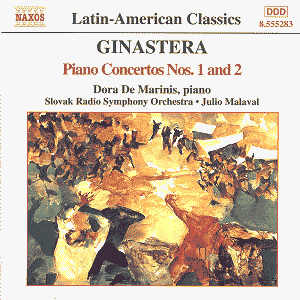Alberto GINASTERA (1916-1983)
Piano Concerto No. 1, Opus 28
Piano Concerto No. 2, Opus 39
 Dora de Marinis (piano)
Dora de Marinis (piano)
Slovak Radio Symphony Orchestra/Julio Malaval
Rec 23-27 April 1999, Bratislava Radio Studios
 NAXOS 8.555283
[66.10]
NAXOS 8.555283
[66.10]
Crotchet
AmazonUK
AmazonUS

Ginastera is one of the most important South American composers of the 20th
century; one of the few to have established a world-wide reputation. And
as with all major composers, his range is wider than easy generalisations
will allow. These piano concertos are dense, powerfully expressive works,
not so much concerned with pianistic display as with expressive intensity
delivered through this particular medium. The first dates from the early
1960s, the second from a decade later.
Commissioned by the Koussevitzky Foundation in the United States, the Concerto
No. 1 is perhaps the more directly approachable of the two works. Certainly
it has a finale whose driving rhythms are most exciting, and bound to make
an impression on the first-time listener. It is marked Toccata concertata
and lives up to this title. At the other extreme is the preceding movement,
very slow at the unequivocal tempo of Adagissimo.
Ginastera's preference for closely argued musical constructions is strongly
communicated in the Second Concerto of 1972, which was commissioned by another
American organisation, the Indianapolis Symphony Orchestra and the concert
pianist Hilde Somer. The composer described the music as creating 'new forms
related to the musical requirements of our time', basing much of it in variation
form on a chord from the finale of Beethoven's Ninth Symphony. This intellectual
conceit is not so directly apparent to the listener, however.
A wide variety of musical approaches can be heard in this piece, though the
whole is tightly constructed, as Ginastera intended. Another point of reference,
Chopin's Funeral March, also plays a part in what he described as
'the tragic and fantastic nature of the Concerto'.
The Naxos sound is better than acceptable, though by no means in the
demonstration class, while the performances might be described in the same
way. The Argentinian pianist and conductor are teamed with a Slovakian orchestra,
performing music which the latter are unlikely to have performed in the concert
hall. All credit to the musicians for the standards they have achieved, in
music which will repay closer attention.
Terry Barfoot

